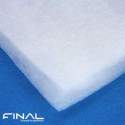Pure Silica Fibre
Final Advanced Materials offers a full range of products in various forms of pure silica including felts.
What are Pure Silicate Fibres
Our pure silica fibre products contain more than 99.95% or silica. They are made from continuous, homogeneous and non-porous filaments. This material is not only one of the most efficient in terms of high-temperature application, but also one of the safest and most ecological on the market.
Pure silica fibre can withstand a continuous temperature of 1,050 °C without undergoing dimensional changes, even in the event of thermal shock, and has a very low thermal conductivity. It also has good chemical resistance, especially to acids. Silica products are particularly valued in aeronautics and aerospace in for their exceptional dielectric properties, especially in the construction of radome.
Manufacturing of Pure Silica Fibres
Quartz is one of the purest form of silica; which is a natural component of many mineral (SiO2). Once it has been crushed and purified, raw material is heated up to its metling point to produce silica. It is then flexed into a fibre which is modified depending on its final use.
Applications of Pure Silica Fibres
- The aerospace and aeronautical industry
- The glass industry
- Insulating industrial furnaces
- Catalytic supports for heating systems
- Replacement of asbestos and ceramic fibres
- Thermal insulation in the manufacture of fibre optics
- Insulation of engines in the aeronautics industry
- Infrared reflector for the thermoforming and lighting industry
- Thermal insulation or catalytic function in the transport industry
- Insulation in the semiconductor industry
- Filtration of hot gases
- Insulation of thermocouples
General Characteristics of Pure Silica Fibres
|
Property |
Unit |
Pure Silica |
|
Density |
g/cm3 |
2.2 |
|
Poisson Coefficient |
- |
0.16 |
|
Dielectric Constant at 10 GHz |
- |
3.74 |
|
Resistitvity at 20 °C |
Ω.m |
1 x 1,020 |
|
Resistitvity at 1,000 °C |
Ω.m |
1 x 108 |
|
Linear Expansion Coefficient |
10-6.K-1 |
0.54 |
|
Max. Operating Temperature |
°C |
1,000 |
|
Peak Temperature |
°C |
1,200 |
|
Specific Heat at 20 °C |
J.kg-1.K-1 |
7.5 x 10² |
|
Thermal Conductivity at 20 °C |
W.m-1.K-1 |
1.38 |
|
Refractive Index |
- |
1.4585 |
Benefits of Pure Silicate Fibres
- No shrinkage at high temperatures
- Environmental friendly manufacturing
- Security guidelines do not apply
- Excellent dielectric properties
- Excellent mechanical properties
- No moiture uptake
- Excellent resistance to fire
- High thermal stability up to 1,050 °C
Comparison
|
Property |
Unit |
Pure Silica |
E-Glass | Kevlar® |
|
Density |
g/cm3 |
2.2 |
2.6 |
1.44 |
|
Poisson Coefficient |
- |
0.16 |
0.25 |
0.36 |
|
Breaking Strength |
MPa |
3,600 |
2,400 |
3,000 |
|
Elongation |
% |
7.7 |
3.5 |
2.4 |
|
Linear Expansion Coefficient |
10-6.K-1 |
0,54 |
2,400 |
- 2 |
|
Max. Operating Temperature |
°C |
1,000 |
3.5 |
300 |
|
Peak Temperature |
°C |
1,200 |
9 |
450 |
|
Specific Heat |
J.kg-1.K-1 |
750 |
2.2 |
1,420 |
|
Thermal Conductivity |
W.m-1.K-1 |
1.38 |
1.38 |
0,4 |
Products from Pure Silica Fibres
Felts, up to 1,200 °C
Pure silica fibre felts have a proportion of silica greater than 99.95 %. They are composed of silica fibre combined with polyvinyl alcohol. The silica fibre of their composition is not only one of the most effective high-temperature materials but is also among the most reliable and ecological on the market. There is no shrinkage even with operating temperatures up to 1,000 °C and they maintain very low thermal conductivity as well as excellent mechanical properties. They can also withstand peak temperatures up to 1,200 °C. These felts are particularly appreciated in the aerospace industry for the insulation of engines thanks to their outstanding insulating and fireproof properties as well as their resistance to vibrations and their very long life.
Other Pure Silica Products
We also offer pure silica fibre in the form of threads, fabrics and loose fibres. Finished products are only produced on request:
- Threads
- Roving
- Bulk Fibre
- Wool
- High- and Low-Density Felts
- Fabrics
- Ropes
- Veiling
Physical variables included in this documentation are provided by way of indication only and do not, under any circumstances, constitute a contractual undertaking. Please contact our technical service if you require any additional information.


